From mustard seeds to sacred offerings, discover the fascinating role of seeds in biblical diets and traditions.

Eating Seeds in the Bible
Navigating the biblical landscape, you'll find seeds not only as staples of diet but also as rich symbols of faith and prosperity. You've likely heard of the mustard seed's significance, but there's a whole garden of narratives and laws surrounding seeds waiting for your exploration.
From grains in sacred offerings to the strict guidelines on consuming them, these small kernels hold a world of meaning. Dive into the ancient texts with us, and you'll uncover how seeds shaped rituals, celebrations, and even the everyday lives of those in biblical times.
Let's unearth these stories together, and perhaps you'll see these humble beginnings in a new light.
Key Takeaways
- Seeds in the Bible symbolize growth, potential, and divine provision.
- Eating seeds may represent partaking in God's blessings and fertility.
- Grain offerings in biblical times underscored thanksgiving for divine sustenance.
- The act of eating seeds aligns with themes of spiritual nourishment and rebirth.
The Symbolism of Seeds

In biblical texts, seeds often symbolize the principles of growth and potential, reflecting deep theological implications about faith and the human condition. This use of seed metaphors permeates scripture, offering insights into the nature of divine promises and human responsibility. You'll notice that seeds aren't merely agricultural entities; they're imbued with spiritual significance, representing beginnings that hold within them the promise of abundant life.
The germination imagery found in the Bible is particularly poignant. Just as a seed must die to bring forth life, so too are believers called to die to themselves to experience spiritual rebirth. This concept is central to understanding the transformative power of faith. It's not just about the initial act of believing but about a continuous process of growth and maturation. The seed, seemingly insignificant and dormant, bursts forth under the right conditions, symbolizing the potential for extraordinary change from humble beginnings.
Moreover, seed metaphors serve as a bridge between the physical and the spiritual realms, teaching that what's sown in the flesh can reap eternal rewards in the spirit. This duality underscores the interconnectedness of temporal actions and eternal consequences. The imagery of scattering seeds, for instance, illustrates the act of spreading the gospel, where the condition of the soil—representing human hearts—determines the fruitfulness of the word.
In analyzing these biblical references, you're encouraged to reflect on the profound layers of meaning behind seed metaphors and germination imagery. They're not just literary devices but tools for deeper theological reflection, highlighting the dynamic interplay between divine providence and human agency.
Grains in Biblical Offerings

Reflecting on the spiritual significance of seeds leads naturally to an exploration of grains used in biblical offerings, where these elements serve as pivotal components in rituals and ceremonies. Grains, symbolizing fertility, sustenance, and life, were meticulously selected and prepared for these sacred occasions. Their use underscores a deep reverence for nature's bounty and a recognition of divine provision.
In the context of biblical offerings, grain preservation techniques were crucial. Ancient practices ensured that the grains remained pure and unblemished, suitable for presentation to the divine. This meticulous attention to grain preservation highlights the importance of offerings in maintaining a tangible connection with the spiritual realm.
Harvest festivals were another key aspect where grains played a central role. These festivals weren't only celebrations of the agricultural year's success but also moments of communal thanksgiving and reflection on the symbiotic relationship between the divine, the land, and the community. Here, grains symbolized the fruition of collective labor and divine blessing.
To understand the significance of grains in biblical offerings, consider:
- Grains as symbols of life and fertility: They represent the sustenance provided by God and the earth's fecundity.
- Grain preservation: This underscores the importance of purity and perfection in offerings, reflecting the respect and reverence towards the divine.
- Harvest festivals: These occasions celebrated the mutual dependence of people, the land, and the divine, with grains symbolizing the blessings of a fruitful harvest.
This exploration reveals the multifaceted roles grains played in biblical offerings, serving not only as offerings themselves but also as symbols of the deeper spiritual and communal bonds within these ancient societies.
The Mustard Seed Parable
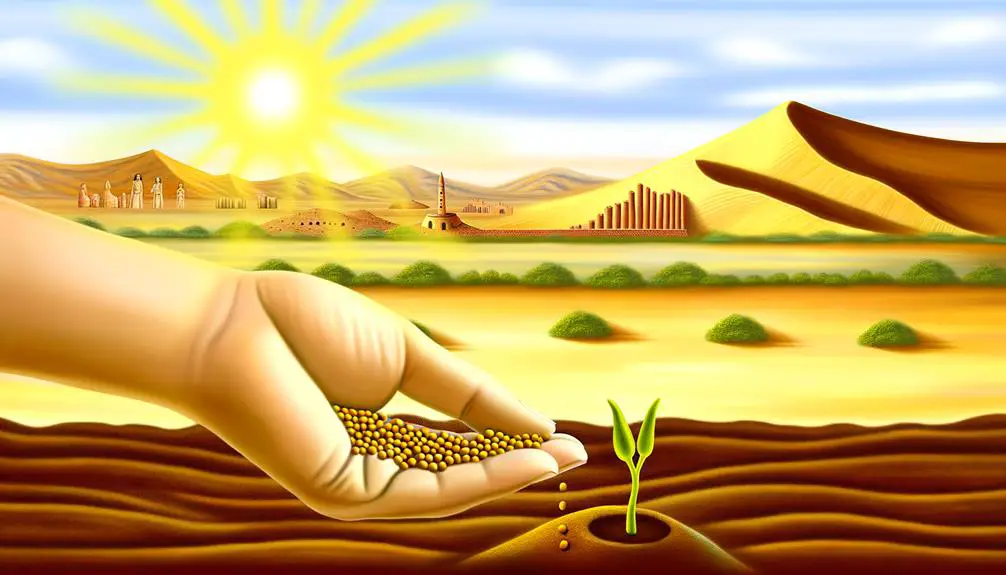
You encounter the Mustard Seed Parable across the synoptic Gospels, where Jesus uses it to illustrate the kingdom of God's nature.
The interpretation of this parable has been a subject of scholarly debate, focusing on its representation of faith's growth from minuscule beginnings.
This symbolism challenges you to reflect on the transformative potential of faith, regardless of its initial size.
Parable Interpretation
The Parable of the Mustard Seed, as recounted in the Synoptic Gospels, invites an interpretation that explores themes of growth and potential within the kingdom of God. This narrative, deeply rooted in seed metaphors and parable origins, unfolds a profound message through the seemingly mundane act of planting a seed.
Key points to consider include:
- Seed metaphors symbolize beginnings and potential, emphasizing the small start of God's kingdom.
- The origins of the parable highlight its universal message across cultures and eras.
- The transformative growth from a tiny seed to a large tree illustrates the expansive reach of faith and God's kingdom.
This analysis underscores the parable's enduring relevance, encouraging reflection on the vast potential residing within the smallest acts of faith.
Faith Growth Symbolism
Building on our understanding of seed metaphors in the Parable of the Mustard Seed, it's crucial to explore how this narrative symbolizes the exponential growth of faith from small beginnings. This parable, deeply embedded in Christian teachings, serves as a powerful illustration of spiritual germination.
You're invited to consider how a seemingly insignificant mustard seed can grow into a large tree. This process mirrors the development of faith, which, starting as a mere speck, can expand into a profound belief system providing shelter and support to many. The parable emphasizes that faith's potential isn't limited by its initial size but is defined by its capacity to grow and nurture.
Through this lens, seed metaphors acquire a profound significance, encapsulating the essence of spiritual evolution and resilience.
Fruits and Fertility
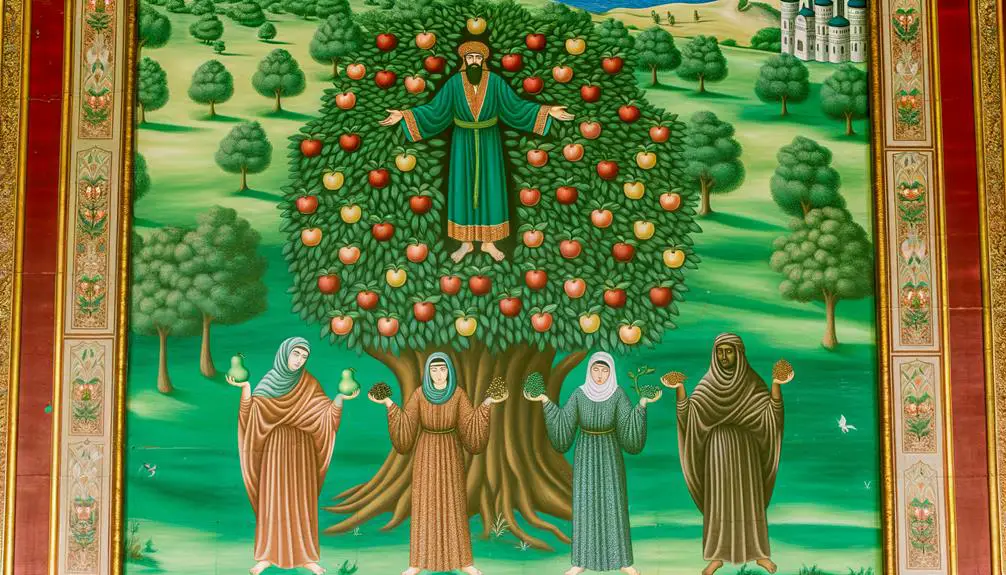
In biblical narratives, fruits often symbolize fertility, embodying themes of growth, prosperity, and divine blessing. This imagery isn't accidental; it's deeply rooted in the biological processes that enable fruit production, such as seed germination and pollination methods. These processes are emblematic of life's continuation and the fruitful yield of one's labor, mirroring spiritual and physical abundance.
Seed germination, the initial step in a plant's life cycle, signifies potential and the start of new growth. It's a process that requires optimal conditions – moisture, temperature, and light – paralleling the nurturing environment needed for spiritual growth. Similarly, pollination methods, which facilitate the transfer of pollen from male to female parts of flowers, ensure the production of seeds and subsequent fruits. This natural mechanism underscores the importance of relationships and community in fostering growth.
The significance of fruits as symbols of fertility in the Bible can be emphasized through three key points:
- Fruits represent the culmination of a series of natural processes, from seed germination to pollination, mirroring the journey from potential to realization.
- They signify God's provision and faithfulness, serving as a tangible reminder of divine care and sustenance.
- Fruits embody the promise of future generations, through the seeds they contain, ensuring the continuation of life.
Understanding these associations enhances one's appreciation of biblical references to fruits, revealing the layers of meaning behind seemingly simple metaphors. This scholarly analysis allows for a deeper comprehension of the text's richness, connecting physical realities with spiritual truths.
Laws Governing Seed Consumption
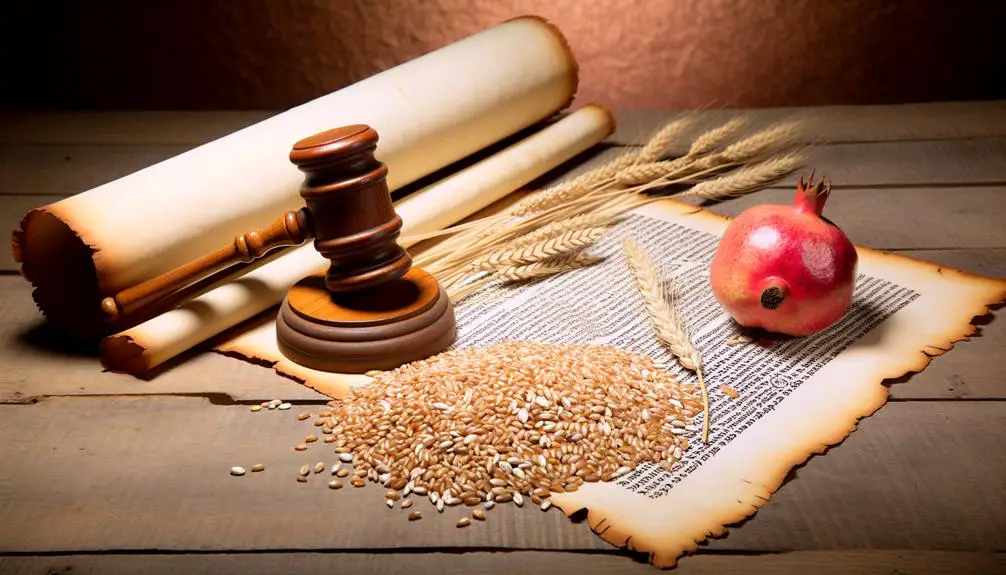
You'll find that the Bible outlines specific rules regarding the usage and consumption of seeds, reflecting their importance in ancient societies.
These regulations range from dietary restrictions to the mandatory tithing and offerings of seeds.
Understanding these directives sheds light on the spiritual and practical significance of seeds within biblical contexts.
Biblical Seed Usage Rules
Several biblical passages outline specific regulations regarding the consumption and handling of seeds, reflecting their importance in ancient agrarian societies. The instructions underscore seed traditions and harness germination metaphors to convey deeper spiritual meanings. These rules serve as both practical guidelines for sustaining physical life and allegorical teachings for nurturing spiritual growth.
Key points include:
- Sowing and Reaping: Emphasizing the principle of sowing seeds in suitable conditions to ensure a fruitful harvest, reflecting the moral of diligence and foresight.
- Tithing: The act of setting aside a portion of one's seeds as an offering, symbolizing faith and dependence on divine provision.
- Fallow Periods: Allowing land to rest, illustrating the value of rest and rejuvenation for both the soil and the soul.
Seed Consumption Restrictions
Ancient texts, notably within the Bible, delineate specific restrictions regarding the consumption of seeds, underscoring their spiritual and practical significance in daily life. These directives not only served immediate health and dietary laws but also symbolized deeper theological meanings.
Biblical Guidance |
Modern Adaptations |
|---|---|
Prohibitions on certain seeds |
Consideration of seed allergies |
Clean and unclean distinctions |
Dietary adjustments for health |
Ritual purity involving seeds |
Inclusion in contemporary cuisine |
Today, you'll find that understanding these ancient restrictions offers insight into managing seed allergies, a concern not explicitly mentioned in biblical times but certainly relevant now. Moreover, the adaptation of these guidelines reflects a thoughtful integration of spiritual discipline with contemporary dietary practices, ensuring that the essence of these teachings remains relevant and respected in modern life.
Tithing and Seed Offerings
Building on the understanding of seed consumption restrictions, it's crucial to explore the role of tithing and seed offerings in the laws that governed seed use in biblical times. These practices weren't merely religious duties; they were integral to societal and economic structures, ensuring community support and religious dedication.
Modern applications of these ancient practices can be seen in:
- Charitable perspectives on giving, where donations support those in need.
- The promotion of sustainable agricultural practices, reflecting stewardship of the earth.
- The encouragement of community solidarity through shared resources.
Such applications highlight the enduring relevance of biblical principles in contemporary society, encouraging a reevaluation of tithing and offerings beyond their historical religious context, towards broader, more inclusive interpretations.
Seeds in Rituals and Celebrations
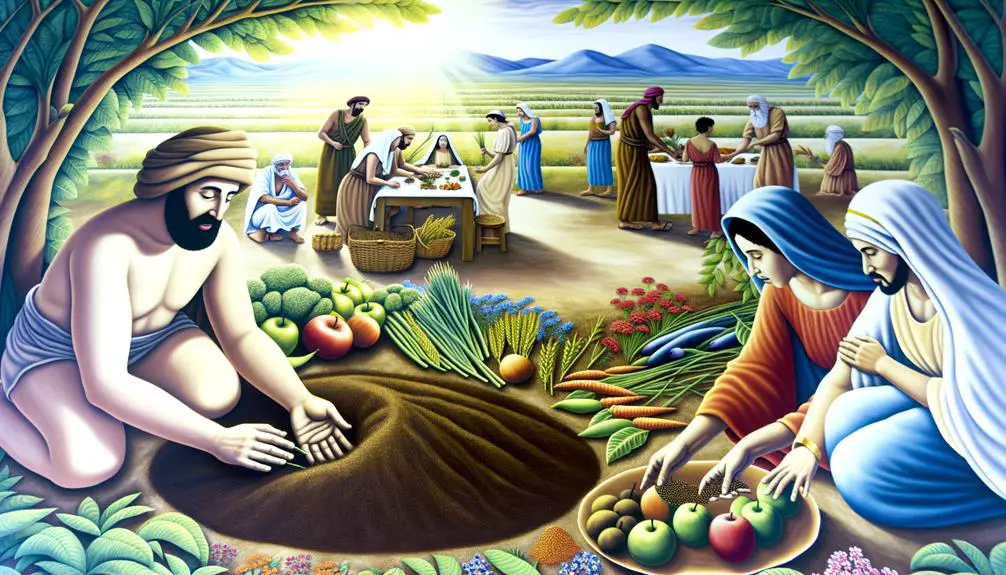
Throughout history, seeds have played a pivotal role in rituals and celebrations, symbolizing rebirth, fertility, and the continuity of life. You'll find that in many cultures, seeds aren't just agricultural commodities; they're imbued with spiritual significance. This reverence is often expressed through practices such as seed fasting and ceremonial plantings.
Seed fasting, for instance, involves abstaining from consuming seeds for a period, to purify the body and spirit before participating in significant religious ceremonies. This practice underscores the belief in seeds as carriers of life and purity, making their temporary absence a form of spiritual cleansing.
Ceremonial plantings, on the other hand, are a proactive expression of faith and hope. By planting seeds during specific rituals, participants symbolically sow their desires for prosperity, growth, and renewal into the earth. These ceremonies often coincide with seasonal cycles, linking human life closely with the rhythms of nature.
Analyzing these practices, it's evident how seeds transcend their biological function. They become vessels of cultural and spiritual values, embodying the interconnectedness of life, death, and rebirth. In these contexts, seeds aren't mere food sources but are revered as sacred gifts from the divine, entrusted to humans for cultivation, preservation, and celebration.
Agricultural Practices of the Ancients
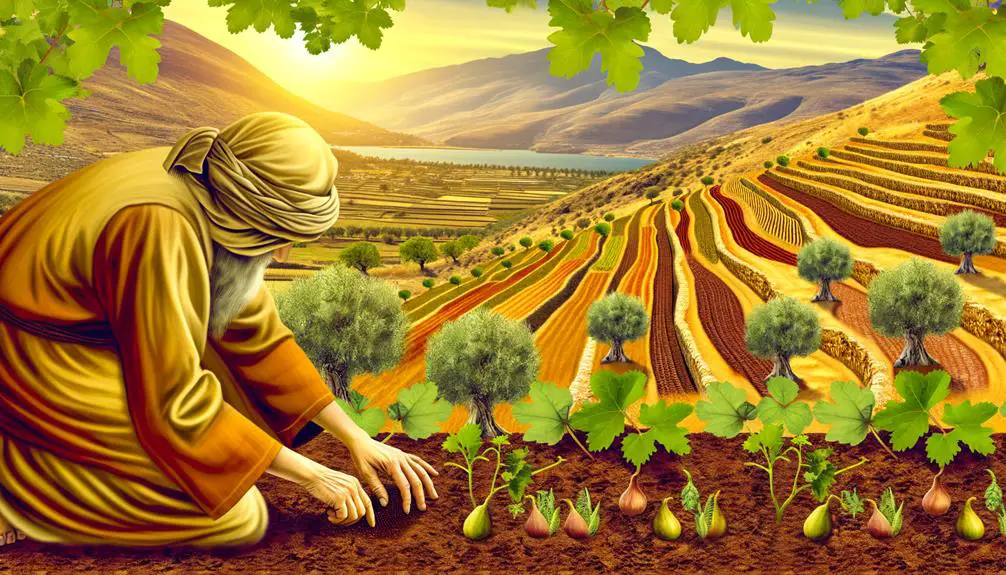
To grasp the evolution of agriculture, one must delve into the practices of ancient civilizations, where seeds weren't only sown but revered, laying the foundation for modern farming techniques. These societies understood the vital role seeds played in their survival and prosperity, leading them to develop sophisticated methods to enhance crop yield and sustainability.
One of the cornerstones of these ancient agricultural practices was crop rotation. This technique involved alternating the types of crops grown in a particular area with each passing season or year. The purpose was twofold:
- To replenish the soil with nutrients that were specific to the needs of the upcoming crops.
- To reduce the buildup of pests and diseases that could decimate a monoculture.
- To manage and conserve moisture levels within the soil, reducing the need for excessive irrigation.
Speaking of irrigation, the ancients devised intricate irrigation techniques to ensure their crops received the water they needed to thrive. These systems ranged from simple canals and ditches to more complex aqueducts and reservoirs, demonstrating an early understanding of engineering and hydrology. They managed water resources with precision, understanding that both scarcity and excess could lead to crop failure.
These practices weren't merely functional; they reflected a deep respect for the natural world and an understanding of the delicate balance required to sustain it. The ancients' approach to agriculture was holistic, integrating crop rotation and irrigation techniques to create a sustainable farming system that laid the groundwork for the methods we use today.
Seeds and the Cycle of Life

Seeds, embodying the essence of life's renewal, play a crucial role in the cyclical nature of agriculture and human sustenance. Through the process of seed dispersal, plants ensure the propagation of their species, a fundamental aspect of agricultural systems. This dispersal, whether by wind, water, or animals, signifies the beginning of a cycle that sustains ecosystems and, by extension, human life. The Bible, with its rich agricultural metaphors, often employs germination metaphors to illustrate spiritual growth and rebirth. These metaphors don't merely symbolize physical growth; they delve deeper into the spiritual and moral development of individuals and communities.
You'll find that the cycle of life, as depicted through seeds in biblical texts, isn't just about the physical act of planting and harvesting. It's a reflection of divine provision and the potential for renewal and transformation. The germination process, where a seed breaks open to give life to a new plant, serves as a potent metaphor for personal and communal rebirth. It's a reminder that from something small and seemingly insignificant, great things can emerge.
The cyclical nature of seed life, with its stages of death, dormancy, and rebirth, mirrors the human experience. It encapsulates the hope for renewal and the promise of new beginnings. By understanding these cycles and the mechanisms of seed dispersal and germination, one gains a deeper appreciation for the interconnectedness of life and the divine wisdom inherent in the natural world. This analytical approach to the biblical representations of seeds and their life cycles invites a profound reflection on the essence of spiritual and physical sustenance.
Frequently Asked Questions
How Did the Dietary Restrictions on Seeds Vary Among Different Communities or Tribes Mentioned in the Bible?
In examining how dietary restrictions on seeds varied among communities or tribes, you'll find differences rooted in seed trading and agricultural rituals. These practices, deeply tied to societal norms and religious beliefs, dictated the consumption and prohibition of certain seeds.
Analyzing these variances offers insight into the broader cultural and spiritual landscape, highlighting how seed-related customs reflected each group's unique identity and relationship with the natural world.
Were There Any Specific Seeds That Were Considered Taboo or Forbidden for Consumption in Biblical Times, and What Was the Reasoning Behind It?
You're delving into a realm where seed blessings intertwine with agricultural practices, reflecting a tapestry of ancient taboos. In biblical times, certain seeds were indeed forbidden, with prohibitions rooted deeply in cultural and religious beliefs. These restrictions not only shaped dietary habits but also mirrored the societal values and spiritual symbolism of the period.
Analyzing these ancient texts reveals a complex relationship between people, their faith, and the natural world around them.
How Did the Handling or Preparation of Seeds for Eating in Biblical Times Differ From Modern Practices?
When examining how seeds were prepared for eating historically, you'll find significant differences from today's methods. Seed fermentation and grinding techniques were pivotal.
Ancient practices often involved fermenting seeds to enhance preservation and flavor, a method less common now. Additionally, seeds were ground using manual tools, contrasting with the mechanical processes we use.
This meticulous approach not only preserved nutrients but also imbued the seeds with a unique taste profile absent in modern practices.
Are There Any Health Benefits or Risks Associated With Seeds That Were Commonly Consumed in Biblical Times, According to Contemporary Nutritional Science?
Did you know that seeds can boost your antioxidant intake by up to 55%?
According to contemporary nutritional science, seeds like those consumed in ancient times are packed with health benefits.
They're rich in antioxidants which combat oxidative stress, and their germination benefits include enhanced nutrient availability.
However, they also carry risks like allergenic compounds or anti-nutritional factors, making it vital to consume them in moderation and after proper preparation.
Did the Consumption of Seeds Have Any Symbolic or Prophetic Implications in Biblical Narratives Outside of the Parables and Direct Teachings?
Yes, aside from parables and teachings, seed symbolism in biblical narratives often carried prophetic seeds, indicating deeper meanings or future events.
For example, seeds symbolize potential and promise, hinting at growth, prosperity, or rebirth. Their use in stories isn't just literal but serves to underline messages of hope, faith, and continuity.
Analyzing these instances, you'll find a rich tapestry of metaphorical and prophetic implications, enriching the textual analysis.
Conclusion
In conclusion, seeds in the Bible aren't just kernels sown into the ground; they're profound symbols of faith, renewal, and sustenance. Analyzing their multifaceted roles—from the humble grain offerings to the potent parable of the mustard seed—reveals a rich tapestry of spiritual and practical wisdom.
Like seeds transforming into bountiful harvests, these biblical references invite us to cultivate deeper understanding and appreciation of life's cyclical nature, nurturing our spirits and communities alike.



Sign up